Mary Anne Yarde's Blog: The Coffee Pot Book Club , page 169
October 2, 2018
The challenges of writing a sequel by Justin A Orton #amwriting #Arthurian #HistoricalFantasy @jaortonwriter
The challenges of writing a sequelBy Justin A Orton

I’m deeply honored to be invited back to Mary’s blog and thought it would be fun to take the opportunity to talk a little about the challenges of writing a sequel.
This past year has seen significant demands on my time at work (even authors need to eat, pay the bills, and feed the cat). At home we’ve just completed a major kitchen renovation (my honey-do list would rival War and Peace) and last month I finally became a US Citizen!
But despite all this – I have continued to work on my true passion, which is writing.
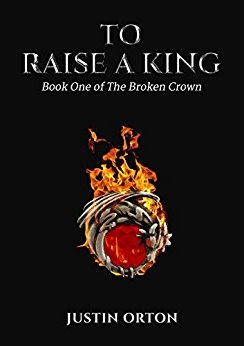 Following the release of “To Raise a King” I found myself embroiled in the minefield of marketing. The Internet seemed suddenly filled with book promotion opportunities. Weeks went by trying to short list all the opportunities out there, and those weeks became months as one learned that not all options were as genuine as they might seem. For a time, I literally became consumed with trying to gain visibility to my work, when I should have just been focusing on the sequel. But there was always tomorrow, and writing the sequel would never be as time consuming or as challenging as the first novel, right?
Following the release of “To Raise a King” I found myself embroiled in the minefield of marketing. The Internet seemed suddenly filled with book promotion opportunities. Weeks went by trying to short list all the opportunities out there, and those weeks became months as one learned that not all options were as genuine as they might seem. For a time, I literally became consumed with trying to gain visibility to my work, when I should have just been focusing on the sequel. But there was always tomorrow, and writing the sequel would never be as time consuming or as challenging as the first novel, right?Wrong!
My first mistake was the thought that writing a sequel would be easy.
Gulp. I said that as a guest author on a blog produced by the author of a stunningly successful series of post Arthurian novels that many, myself included, have come to love! I’m not worthy, but I’m here, so I’ll continue…
When writing a novel, a lot of work goes into the setting and the characters, not just the plot. A great story will be empty without interesting characters, realistic dialog, and scenes that unfold in locations the reader can feel, see and smell. With a sequel it would be easy to assume that work has already been done. The author knows the characters intimately. They know every detail of the scenes, the settings, and the costumes. The author has lived with their creations for months, even years, and the first fundamental mistake one makes is believing the readers know everything too!

This poses four problems:
• Readers may not start with Book one. So how much do you retell without boring those that did read book one?• • In the unlikely event the readers really do know the characters as well as the author, then what is left to tell in the sequel? The second book must have a stunning plot to replace the pages normally spent introducing characters.• • If the readers really don’t know the characters as well as the author does (or thinks the readers do), then almost as much work goes into character building in the sequel as went into the initial book, sometimes more!• • The author is faced with the challenge of ensuring each character stays within the framework created in the previous books, or grows in a manner that is believable and consistent.
Maintaining continuity becomes a nightmare!
Characters often have a nasty habit of changing their story on you, sometimes in ways you don’t even realize. In a sequel you are not only continuing the story, but you must also strive to give your readers more. Each character needs more depth, delighting the reader as they make new discoveries. As the words start to flow across the page you suddenly realize that a simple innocent scene in the previous book has impacted book two in ways you never imagined.
I’ve lost count of the number of times I wanted to go back and just remove a scene or have someone unsay a line of dialog that at the time of writing seemed to have no significant bearing on the books to follow but has annoyingly committed me to a path or history I would not have chosen.
When I began “To Raise a King” I knew who I wanted the characters to be. I knew their backstories (most of them anyway). I knew how the entire series would start and end, with a high-level view of the journey in between. But despite that roadmap I’ve still stumbled.
So, as book two has been written, re-written, scrapped, and written again, I’ve found myself taking much greater care over every scene. Everything is analyzed not just for its immediate value to the story, but for its potential impact on the finale. I’m making much better use of the writing tools I have (Scrivener), to track characters, locations, objects and even the weather! That effort now, will allow me to spend far less time fact checking book three against its two predecessors, which means I will have more time to spend doing what I and my readers want, which is producing the next book!

Another unexpected challenge came from the fans. Those that enjoyed the book and were gracious enough to leave a review or contact me personally have directly or indirectly impacted some of the events in the next two books. Side characters that I never expected to see again turned out to be popular, and some of these (no I won’t tell you who) have found their way into the series. In some cases, this has meant finding a place for them in a way that enhances the story, not distracts from it. I must confess this has been a delightful distraction for me as it has not only challenged me to grow characters that I didn’t know well, but it feels that I’m really giving something to the reader that they influenced.
Then there’s the critics. I've had a lot of reviews on the first book, and even won a few awards. But not all reviews are good, and not all feedback is kind, but every single review, critique and comment has been appreciated, and more importantly has had an impact on the sequel. I’ve learned so much along the way and can honestly say that not only characters grow through the development of a series, but so does the author. I've tried very hard to wring every lesson from every comment and it is my hope that those that enjoyed “To Raise a King” will love “To Save a Queen”.
So, if I haven’t bored you to tears yet, allow me to tell a little about the upcoming book, which is now going through its final author cut before being sent for editing.
To Save A Queen
*Possible spoiler alert for To Raise a King.*

“To Save a Queen” picks up right where the first book ended. “To Raise a King” focused heavily on stage setting, and backstory, with Matt’s immediate quest to recover the fragments of Arthur’s crown. The sequel focuses more on the characters as they jostle for position in preparation for the final showdown.
An exhausted Morgause, now in possession of the Rod of Dardanos must crush the newly returned Arthur before he can rise to challenge her, but that leaves the upstart Aldivon at her back.
Aldivon, in possession of the Crystals of Dardanos, has retreated, his plan to overthrow Morgause and Merlin in tatters. Should he seek an alliance or fight on? His prisoner, Valina, may hold the answer as she comes to understand that Aldivon’s mind is not necessarily his own.
Merlin has collapsed. Pushing himself too far, he has drained himself to the point of death, and Matt finds himself torn between love and loyalty as Arthur and Lancelot struggle to put their differences aside.
Amid this three-way power struggle a fourth character emerges. Hunted by the queen, Guenevere narrowly escapes death, and decides to take matters into her own hands.With the future of the world hanging in the balance, each group finds themselves embroiled in a bitter effort “To Save a Queen”.
I wish I could provide a release date for “To Save a Queen”, but all I can promise is 2019. I am working hard on the project, but I want to bring you a tale of magic, mystery, romance and action that will leave you clamoring for the final installment. You’ve had to wait, but I hope you’ll find it was worth it.
Now, in closing I would like to offer heartfelt thanks to my readers, critics, friends and family. You’ve encouraged and challenged me! Lisa, my wife, who despite the afore mentioned “Honey Do” list knows how important my journey as an author is to me, thank you for your support.
And finally - special thanks to Mary for allowing me a place on her ever-popular blog.
Happy reading everyone!
Justin
Justin A Orton
 I spend most days delving into the world of computer code and unraveling programming mysteries for many major corporations, but my true passion is fictional writing.
I spend most days delving into the world of computer code and unraveling programming mysteries for many major corporations, but my true passion is fictional writing.My work is always supervised by Oliver (my cat), who’s four-legged contributions can often be found in both my coding and writing (all spelnig errors r stritcly his!).
I was born and raised in England, but now live with my beautiful wife Lisa in Florida (famous for its theme parks, beaches, the occasional hurricane, and a certain mouse).
My hobbies include: reading, movies, history, travel (I want to see mountains again Gandalf – mountains!), and exploring the latest gadgets and gizmos.
I’m rather fond of single malt scotch and it’s not uncommon to find me of an evening, sipping on a fine dram, while pondering how to get a character out of the very awkward situation I recently put them in!
Justin loves to hear from readers, you can find him: Website • Twitter • Facebook • GoodReads.
Published on October 02, 2018 23:00
October 1, 2018
Life in the Time of Sailing Ships by Jayne Davis #History #Ships #Regency @jaynedavis142
Life in the Time of Sailing Ships By Jayne Davis
Some nautical phrases that have entered everyday language, and changed their meaning.A second-rate ship…Today, this phrase would mean a ship that was sub-standard in some way, not as good as it could be. This was the case originally, too, but only in terms of fire-power. Warships were rated from 1st rate to 6th rate depending on the number of guns they were designed to carry. This also correlated with the size of the vessel – the more guns it carried, the more men were needed to man them and the bigger the ship had to be.Nelson’s flagship, HMS Victory, had 104 guns on three gun decks, making it a 1st rate ship of the line.
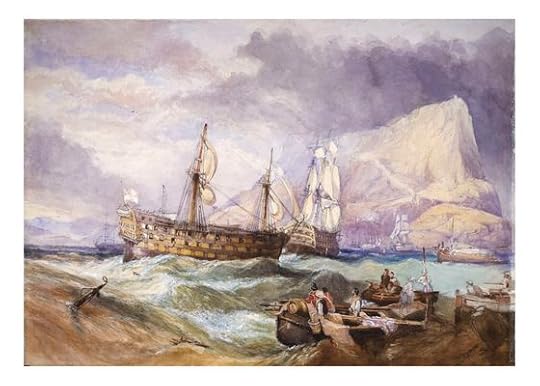 The damaged HMS Victory being towed into Gibraltar after the Battle of Trafalgar. HMS Victory is now in Portsmouth Historic Dockyard in the UK.
The damaged HMS Victory being towed into Gibraltar after the Battle of Trafalgar. HMS Victory is now in Portsmouth Historic Dockyard in the UK.The table shows the rating system used during the Napoleonic Wars. (Information from Wikipedia) Rate Guns Gun decks Men 1st >100 3 850-875 2nd 90-98 3 700-750 3rd 64-80 2 500-650 4th 50-60 2 320-402 5th 32-44 1 or 2 200-300 6th 20-28 1 340-550
1st, 2nd and 3rd rate ships were referred to as ships of the line. There were very few 1st and 2ndrate ships (less than 10 of each), but many more 3rd rate ships. 5thand 6th rate ships were called frigates (although the term was sometimes used quite loosely). Smaller ships such as sloops-of-war, gun-brigs etc were unrated.
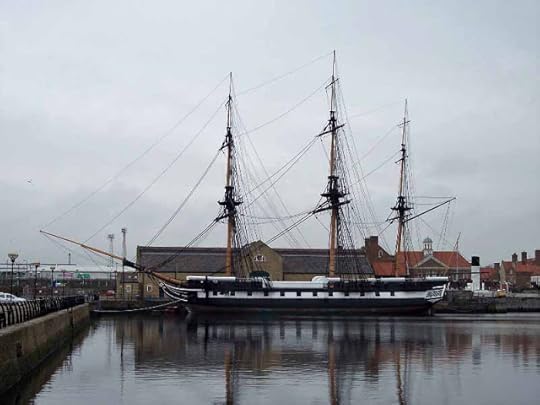 HMS Trincomalee is a frigate built right at the end of the Napoleonic Wars, and can be visited in Hartlepool, UK.
HMS Trincomalee is a frigate built right at the end of the Napoleonic Wars, and can be visited in Hartlepool, UK.Loose cannonToday, a loose cannon is a dangerously uncontrollable person, and the origin of the phrase is from a cannon that has come loose. Loose from what, you may ask.The photo below shows the cannon on one of HMS Victory’s gun decks.
 One of HMS Victory’s gun decks. Sadly almost all of the guns on display on the ship today are made of fibreglass, as the old structure is not strong enough to take the weight of real ones.
One of HMS Victory’s gun decks. Sadly almost all of the guns on display on the ship today are made of fibreglass, as the old structure is not strong enough to take the weight of real ones.The largest guns on Victory were 32 pounders—this meant the weight of each cannonball was 32 lbs (15 kg). The cannon itself weighed about 56 hundredweight, or nearly 3 tonnes. The thick ropes in the photo are to absorb the force of the recoil when the gun fires, and limit the movement to a few feet. This is enough to allow men to reload it, before the thinner ropes are used to pull it closer to the bulkhead again for the next shot.A ship at sea is rarely still, and often pitching and rolling violently. I leave you to imagine the damage that could be if the restraining ropes break. With 3 tonnes of metal loose on a rolling deck, a ‘loose cannon’ could be very dangerous indeed.Nipper‘Nipper’ is UK slang for a child, and comes from the boys used to ‘nip’ anchor cables.
 HMS Victory, showing one of her anchors and its cable, with a handy dockyard worker for scale.
HMS Victory, showing one of her anchors and its cable, with a handy dockyard worker for scale.As you can see in the photo, the anchor cable is at least as thick as the man’s arm. Each anchor weighed a couple of tonnes, and the length of cable itself weighed over 4 tonnes. On Victory, the anchor was ‘weighed’ by over 100 men turning two capstans (one mounted above the other on two decks). This cable is far too thick and stiff to be wound around the capstan, so the anchor cable was ‘nipped’ (i.e. fastened) to a thinner, more flexible rope called the messenger cable.

Young boys were responsible for fastening the anchor cable to the messenger cable, then unfastening it again before the anchor cable was fed down to its storage on the orlop deck, and were called nippers.There’s a video here that explains in more detail, if you’re interested (not my video!):
That’s it for now, there are lots more!
The Mrs MacKinnons
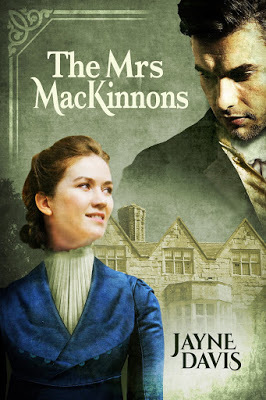 England, 1799Major Matthew Southam returns from India, hoping to put the trauma of war behind him and forget his past. Instead, he finds a derelict estate and a family who wish he'd died abroad.Charlotte MacKinnon married without love to avoid her father’s unpleasant choice of husband. Now a widow with a young son, she lives in a small Cotswold village with only the money she earns by her writing.Matthew is haunted by his past, and Charlotte is fearful of her father’s renewed meddling in her future. After a disastrous first meeting, can they help each other find happiness?
England, 1799Major Matthew Southam returns from India, hoping to put the trauma of war behind him and forget his past. Instead, he finds a derelict estate and a family who wish he'd died abroad.Charlotte MacKinnon married without love to avoid her father’s unpleasant choice of husband. Now a widow with a young son, she lives in a small Cotswold village with only the money she earns by her writing.Matthew is haunted by his past, and Charlotte is fearful of her father’s renewed meddling in her future. After a disastrous first meeting, can they help each other find happiness?4.7* average on Amazon, available on Kindle Unlimited.Amazon
Jayne Davis
 Jayne Davis writes historical romances set in the late Georgian/Regency era, published as both ebooks and paperbacks.She was hooked on Jane Austen and Georgette Heyer as a teenager, and longed to write similar novels herself. Real life intervened, and she had several careers, including as a non-fiction author under another name. That wasn't quitethe writing career she had in mind...Finally, she got around to polishing up stories written for her own amusement in long winter evenings, and became the kind of author she’d dreamed of in her teens. She is now working on the first few books in the Marstone Series, set in the late Georgian/early Regency period.
Jayne Davis writes historical romances set in the late Georgian/Regency era, published as both ebooks and paperbacks.She was hooked on Jane Austen and Georgette Heyer as a teenager, and longed to write similar novels herself. Real life intervened, and she had several careers, including as a non-fiction author under another name. That wasn't quitethe writing career she had in mind...Finally, she got around to polishing up stories written for her own amusement in long winter evenings, and became the kind of author she’d dreamed of in her teens. She is now working on the first few books in the Marstone Series, set in the late Georgian/early Regency period.You can find Jayne: Website • Pinterest.
Published on October 01, 2018 23:00
September 30, 2018
Life in the time of … the Amboyna Massacre of 1623 by Yvette Bostic #History #Indonesia @YvetteBostic
Life in the time of … the Amboyna Massacre of 1623By Yvette Bostic
 The Dutch and English enclaves at Amboyna (top) and Banda-Neira (bottom). 1655 engraving — Wikipedia.
The Dutch and English enclaves at Amboyna (top) and Banda-Neira (bottom). 1655 engraving — Wikipedia.In my quest for a suitable timeline for my novella, Light’s Dawn, I stumbled upon the Amboyna Massacre of 1623. I’d never heard of it, but was immediately drawn in by the tale.
The Ambon Island (now known as Maluku, Indonesia) was the setting for a brutal rivalry between the East India Trade Company of England and the Dutch Republic in the spice trade.
In 1605, the Dutch East India Company (VOC) conquered the Portuguese fortress of Victoria at Amboyna, thus taking over the trading interests as well. This did not set well with the other European traders as they feared the Dutch would monopolize trade in the area. Tensions increased with each passing year until 1619, when King James I and the Netherlands States General signed the Treaty of Defence in London creating cooperation in the East Indies. Despite the treaty, relations between the companies remained unsettled, with numerous grievances and accusations of treaty breaches.
Finally, at the end of the year 1622, the Dutch suspected the Sultan of Ternate of switching allegiances to the Spanish. They accused the English traders at Amboyna of swaying the Sultan’s allegiance.
In February of 1623, the Dutch apprehended a ronin spy within the fortress who admitted under torture that they intended to assassinate the Dutch governor at Victoria. The spy also implicated the English in the conspiracy. Subsequently, the Dutch imprisoned and questioned many of the English, Portuguese and Japanese and ultimately executed twenty prisoners. According to the Dutch trial records, most suspects confirmed their guilt and were charged with treason. Twenty men were executed, while four Englishman and two Japanese were pardoned and allowed to leave.
But the affair was not settled. The men who were pardoned took their plea to England, claiming severe torture and false accusations. The two sides agreed to an investigation which led to the trial of the court judges at Amboyna. The draft-verdict of acquittal was rejected by King Charles, but the accused judges were still released from house arrest.
In 1654, the VOC paid reparations to the heirs and the East India Trade Company, but the hostilities still did not end. The English and Dutch entered the first Anglo-Dutch war in 1652, followed by the second and third Anglo-Dutch wars.
It’s difficult to know the truth of the story as both sides claim innocence. But the event has been reported to be the catalyst of many disagreements and the spark that lit the flame of the first Anglo-Dutch war.
The first few chapters of Light’s Dawn guide us through Mikel’s escape from Ambon Island. I attempted to stay true to historical events, but mine is a story of demons and the powerful group of gifted men and women fated to stop them. It is my hope that history buffs embrace the nonsensical and fantasy lovers appreciate the history.
References: https://en.wikipedia.org/wiki/Amboyna_massacrehttps://en.wikipedia.org/wiki/Dutch_Brazil#Unsuccessful_1624_invasionPublic Domain, https://commons.wikimedia.org/w/index.php?curid=798763
Light's Dawn: A Novella (Light in the Darkness)
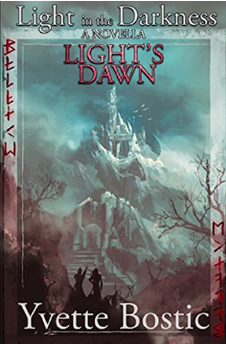 Mikel, a young merchant with the East India Trading Company, always considered fortune to be his mistress...until the Amboyan Massacre. The Dutch spare his life, but he’s forced into the deep jungles of South America to act as bait for a hidden menace picking off their scouts one by one. It works all too well: a demonic horde, drawn into the open, annihilates the entire Dutch battalion, leaving Mikel running for his life.
Mikel, a young merchant with the East India Trading Company, always considered fortune to be his mistress...until the Amboyan Massacre. The Dutch spare his life, but he’s forced into the deep jungles of South America to act as bait for a hidden menace picking off their scouts one by one. It works all too well: a demonic horde, drawn into the open, annihilates the entire Dutch battalion, leaving Mikel running for his life.As he flees from the grisly battlefield, he falls in with the only other survivor of the demon attack, a Portuguese army scout named Raphael. Together, they scramble to escape the dangers of an impenetrable jungle, the pursuing demons, and their masters, a shadowy group of cultists intent on destroying the world.
Exhausted and disoriented, Mikel and Raphael are drawn to a mysterious stranger. But his gifts come with a choice: accept their destiny to fight against the darkness or allow it to consume humanity.
Light's Dawn is a stand-alone prequel to the Light in the Darkness historical fantasy series.
Amazon UK • Amazon US
Yvette Bostic
 Yvette lives in the beautiful mountains of West Virginia. During the day she has a full-time career, but when she gets home and kicks off her shoes she becomes absorbed in her next novel. She enjoys the company of her ever-patient husband who believes she's lost in her computer, and three dogs who are the only ones who can drag her away from writing-mostly because she has no desire to clean up their mess.Yvette loves to hear from readers, you can find her: Website Facebook Twitter
Yvette lives in the beautiful mountains of West Virginia. During the day she has a full-time career, but when she gets home and kicks off her shoes she becomes absorbed in her next novel. She enjoys the company of her ever-patient husband who believes she's lost in her computer, and three dogs who are the only ones who can drag her away from writing-mostly because she has no desire to clean up their mess.Yvette loves to hear from readers, you can find her: Website Facebook Twitter
Published on September 30, 2018 23:00
September 28, 2018
A Conversation with D. K. Marley #Shakespeare #Marlowe @theRealDKMarley
A Conversation with D. K. Marley
 DK Marley is a historical fiction writer specializing in Shakespearean themes. Her grandmother, an English professor, gave her a volume of Shakespeare's plays when she was eleven, inspiring DK to delve further into the rich Elizabethan language. Eleven years ago she began the research leading to the publication of her first novel "Blood and Ink," an epic tale of lost dreams, spurned love, jealousy and deception in Tudor England as the two men, William Shakespeare and Kit Marlowe, fight for one name and the famous works now known as the Shakespeare Folio.
DK Marley is a historical fiction writer specializing in Shakespearean themes. Her grandmother, an English professor, gave her a volume of Shakespeare's plays when she was eleven, inspiring DK to delve further into the rich Elizabethan language. Eleven years ago she began the research leading to the publication of her first novel "Blood and Ink," an epic tale of lost dreams, spurned love, jealousy and deception in Tudor England as the two men, William Shakespeare and Kit Marlowe, fight for one name and the famous works now known as the Shakespeare Folio.It is so wonderful to have you come back onto the blog. I know you are passionate about the works of Shakespeare and Marlow, and I would like to explore that passion with you today. There have been many novels about Shakespeare, why did you feel it was important to write about this particular topic?
Yes, there are many novels on Shakespeare, expounding the continued belief that he wrote the plays and sonnets attributed to him, but this novel gives wing to the possibility of someone else being the writer.
 The Chandos Portrait (held by the National Portrait Gallery, London)
The Chandos Portrait (held by the National Portrait Gallery, London)So, this novel is of historical importance?
I would rather say it is of historical interest. I am not a historian. Even though I love doing research for my novels, my passion is fiction and a story like this that is rich with intrigue and theories, well, it is the stuff historical fiction writers dream about. Both characters, William Shakespeare and Christopher Marlowe, have a world full of questions surrounding them. There are endless avenues any writer can traverse when it comes to these two men.
What made you want to write about Marlowe and Shakespeare?
The first time I visited England in 1997, I took a tour of the Globe Theatre and there in the museum was a wall dedicated to the five other men who may have written the plays, a thought I had never imagined before. To this day, I truly don't know why Marlowe stood out to me, but I took out my notebook and began writing notes about him, knowing a story was there.
 Shakespeare's Globe, London, England.
Shakespeare's Globe, London, England.When I came back home and started researching on the Internet about the possibility, I came across some amazing discoveries. The more and more I delved, the more the theory sounded plausible. Given the fact that Marlowe was already a playwright and had access to far greater resources than Shakespeare ever did, the idea had merit, but the problem was the issue with his death at the age of twenty-nine in Deptford.
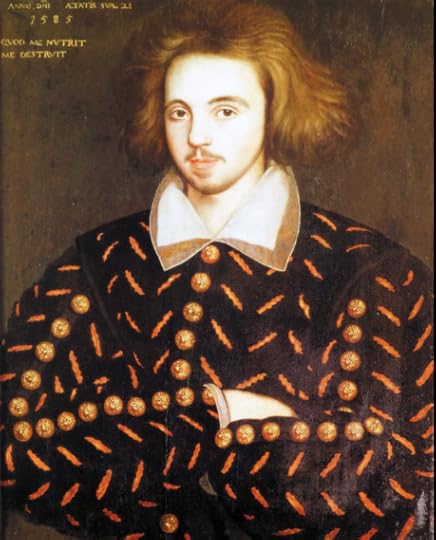 An anonymous portrait in Corpus Christi College, Cambridge, believed to show Christopher Marlowe.
An anonymous portrait in Corpus Christi College, Cambridge, believed to show Christopher Marlowe.When I came across Peter Farey's discussion, the problem resolved and all of my questions melded together into one solution: he never died, but was exiled. This was truly a sixteenth century case of conspiracy and identity theft. The idea of a crime novel or suspense was quite interesting to me, even something on the line of Dan Brown's books, but in finding my own voice, historical fiction felt more like home, especially the time period of the Tudors. The Elizabethan era has always been my favorite period and I love tackling the job of weaving a bit of the old language with our modern tongue. While I tried to stay true to history, I did use artistic license, such as the additions of the subplot of Marlowe's imaginary friend, to round out a writer's torture who is plagued with a “muse,” as was Marlowe who was referred to as the “muse's darling.”
My grandmother gave me my first book of the complete works of Shakespeare when I was eleven years old. The language, the history, and the style of writing has intrigued me ever since. During my school years, I immersed myself into English Literature, even acting the part of Calpurnia in Julius Caesar when we studied that play.
There will be many who scoff at the idea that Shakespeare was merely an ambitious actor who stole the works of Marlowe; how do you approach this?
Of course, there will, and I expect that, but again, I do not claim to be a Shakespearean scholar or historian. Yet, sometimes the simplest of explanations lean more toward truth than elaboration. That is why I used the quote from Francis Bacon, who himself is another candidate for writing the plays - “The forbidden idea contains a spark of truth that flies up in the face of he who seeks to stamp it out.”
There may be a spark of truth to the idea that Shakespeare did not write the plays and there always will be those who wish to stamp out debate.
This is the same kind of wall the writers and men of ambition and progress, those of the “School of Night” faced during the Elizabethan era. I have been to some delightful debates over the years discussing the question of Shakespeare's authorship, the first and foremost being the lectures held at the Globe Theater in 2007.
There is even a petition people can sign on the internet called the Declaration of Intent for the Shakespeare Authorship Debate, although the site supports Edward de Vere, the Earl of Oxford, as being the writer, which is fine with me, for any support for anyone other than the man Shakespeare shows I am not alone in believing that this actor from Stratford was not the man who wrote such eloquent and astounding verses; and yet, I am not against those who do believe.
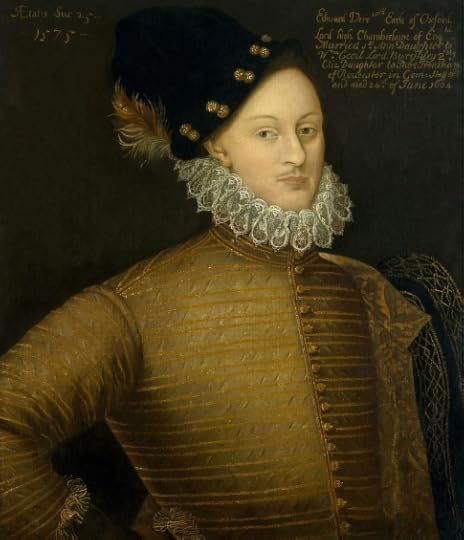 Portrait of Edward de Vere, 17th Earl of Oxford (1550-1604)
Portrait of Edward de Vere, 17th Earl of Oxford (1550-1604) The question reminds me of a small episode where this very thing took place. I was standing in a group at the first debate held at the Globe and a gentleman looked at me when he discovered I was a Marlowan, and said, “O, you are one of those. I suppose you believe he was exiled.” Very calmly, I replied, “Well, you have to admit that the idea makes for a great story, and that is what I am, a story teller.”
What kind of evidence is there that Marlowe survived the tavern brawl in Deptford? And what evidence is there against William Shakespeare being the writer?
To me, Marlowe was as a brilliant writer as he was a spy. A man who could create such astounding characters, even if you only attribute those we know about – Faustus, Tamburlaine, Edward – shows he had the ability to form well-rounded characters. Walsingham was known for recruiting boys of genius at a young age for the underground spy ring, so a boy of Marlowe's caliber, a boy and man who could morph characters, would have fit into Walsingham's plans. It would not have been a difficult thing for Marlowe to do as a writer, for oftentimes writers use this technique for getting into the minds of their characters.
What kind of questions should a person ask who is looking to do some research on this topic?
1. Do we know Marlowe survived the death in Deptford without a doubt? No, but tell me this:2. Why was one of the most beloved playwrights of his day, before Shakespeare, buried in a common churchyard?3. Why did the Queen provide her own coroner for the inquest when she herself was not within the verge of the murder, and then give instructions that no one delve further into questionings about Marlowe's death?4. Why was Marlowe with three other well-known spies instead of presenting himself before the Privy Council at eleven o'clock, which was his punishment for the supposed seditious writings found in Kyd's apartments?5. Who is the mysterious man known simply as Monsieur Le Doux during those years Marlowe would have been dead?6. Why do we not hear anything about Shakespeare's writings until after Marlowe dies?7. Who is the Mr. W. H. to whom the sonnets are dedicated?8. Who is the “dark lady” of the sonnets?9. What kind of education did the two men have?10. What is the secret riddle of the epitaph above Shakespeare's tomb?11. Why was his grave dug twelve feet deep instead of the normal six foot?12. Why did Shakespeare's son-in-law, Dr. John Hall, leave off any mention of the day Shakespeare died in his journal?
There are so many questions, I could go on and on. If a person holds up all of these in relation to Shakespeare, the questions loom; and yet, when I held up each of these questions to Marlowe, all the answers, for me, fell into place.
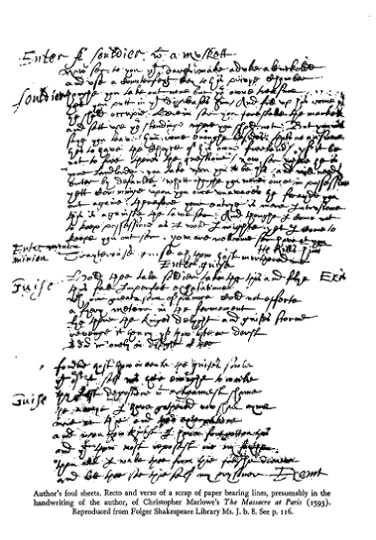 A foul sheet from Marlowe's writing of The Massacre at Paris (1593)
A foul sheet from Marlowe's writing of The Massacre at Paris (1593)Shakespeare did not have the education for such lofty writing, he did not have the background and there is no evidence of his having traveled. Even his friend, Ben Jonson, railed him on his lack of languages. Also, maybe just to me, but I thought it odd, there is no mention of his writings, or any books he may have had in his possession for his own research, in his will. For those in favor of Shakespeare, I am sure they will say it is because the plays belonged to the playhouse and the actors, but still, to me, there is a question.
There is no doubt Shakespeare was an ambitious man and a brilliant actor, and considering the time period he lived with poverty and sickness so rampant, a man might do anything to make sure of the survival of his family, the legacy of his name and his own ambition.
When you read some of the sonnets, many of the ones I have quoted in the novel, the desperation of a man writing the words resounds. Clearly, the sonnets show a man desperate for someone to recognize the hidden clues, clues that smack of the life of Marlowe, not Shakespeare. It was a common practice in those days to hide clues or riddles within writings, so this style of writing would not have been unusual for Marlowe. Also, he had all the means available to him to undertake a masque to save his own life – the money, the backing, the patrons, and a favor from the Queen herself, who was known to take great pains to protect those who protected her.
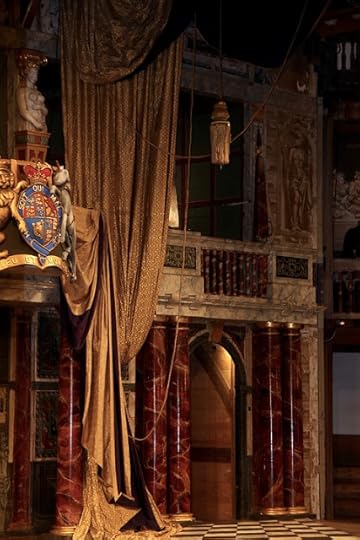 Shakespeare's Globe, London, England.
Shakespeare's Globe, London, England.Any final thoughts on the Shakespeare authorship question? Yea, simply this – an early American author, Napolean Hill, said, “All great truths are simple in final analysis, and easily understood; if they are not, they are not great truths.”
So, are you saying after all of this that you are a strict Marlowan and not a Stratfordian?
Well, no. I am saying that there are reasonable questions to the debate, and I am saying that the premise makes for a great story; but in truth, we will never know unless someone stumbles upon some profound letter one day revealing to the world the true author. Until then, I will remain an avid Shakespeare-lover. There are questions I have, but I have no questions about the beauty and genius behind the works themselves.
Thank you so much for coming onto the blog today and sharing your thoughts on Shakespeare and Marlow! I shall certainly have to check out your book!
Blood and Ink
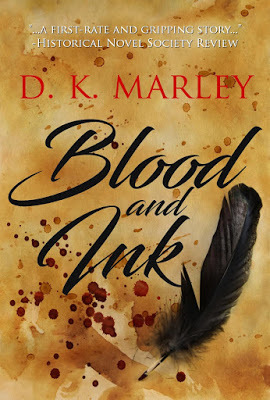 History shows Kit Marlowe died in a tavern brawl in Deptford in 1593, but did he? England is torn by religious metamorphosis and espionage. The stages of England and bright intellectual boys are used to bolster Queen Elizabeth I's reign and propagate the rising Protestant faith. At the age of eight, Christopher Marlowe, the muse's darling, is sucked into the labyrinth of secret spy rings, blood, murder, and betrayal, while his own ambition as England's favorite playwright drifts further from his grasp. As Christopher grows to manhood, he sinks further into the darkness, and a chance meeting with an unknown actor from Stratford-upon-Avon, William Shakespeare, sets him on a path of destiny; a fate of forced exile and the revelation that the real enemy was not the assassins of Rome, but a man who stared into his eyes and smiled. One he did not expect...
History shows Kit Marlowe died in a tavern brawl in Deptford in 1593, but did he? England is torn by religious metamorphosis and espionage. The stages of England and bright intellectual boys are used to bolster Queen Elizabeth I's reign and propagate the rising Protestant faith. At the age of eight, Christopher Marlowe, the muse's darling, is sucked into the labyrinth of secret spy rings, blood, murder, and betrayal, while his own ambition as England's favorite playwright drifts further from his grasp. As Christopher grows to manhood, he sinks further into the darkness, and a chance meeting with an unknown actor from Stratford-upon-Avon, William Shakespeare, sets him on a path of destiny; a fate of forced exile and the revelation that the real enemy was not the assassins of Rome, but a man who stared into his eyes and smiled. One he did not expect...Amazon • Barnes and NobleAuthor’s Website
D.K. Marley
 DK Marley is a historical fiction writer specializing in Shakespearean themes. Her grandmother, an English professor, gave her a volume of Shakespeare's plays when she was eleven, inspiring DK to delve further into the rich Elizabethan language. Eleven years ago she began the research leading to the publication of her first novel "Blood and Ink," an epic tale of lost dreams, spurned love, jealousy and deception in Tudor England as the two men, William Shakespeare and Kit Marlowe, fight for one name and the famous works now known as the Shakespeare Folio.
DK Marley is a historical fiction writer specializing in Shakespearean themes. Her grandmother, an English professor, gave her a volume of Shakespeare's plays when she was eleven, inspiring DK to delve further into the rich Elizabethan language. Eleven years ago she began the research leading to the publication of her first novel "Blood and Ink," an epic tale of lost dreams, spurned love, jealousy and deception in Tudor England as the two men, William Shakespeare and Kit Marlowe, fight for one name and the famous works now known as the Shakespeare Folio.She is a true Stratfordian (despite the topic of her novel "Blood and Ink"), a Marlowe fan, a member of the Marlowe Society, the Shakespeare Fellowship and a signer of the Declaration of Intent for the Shakespeare Authorship Debate. Her new series titled "The Fractured Shakespeare Series" will tackle adapting each play into a historical fiction novel. She has traveled to England three times for intensive research and debate workshops and is a graduate of the intense training workshop "The Writer's Retreat Workshop" founded by Gary Provost and hosted by Jason Sitzes and Lorin Oberweger. She is also a blogger for her blog "The Jabberwocky Blog" on Wordpress. She lives in Georgia with her husband and two Scottish Terriers named Maggie and Buster.
Connect with D.K. Marley: Author Website • Facebook • Twitter • Instagram: @theRealDKMarley •Amazon Author Page • Goodreads • Jol's Book Club.
Published on September 28, 2018 23:00
September 27, 2018
Book Spotlight — A Suggestion of Scandal by Catherine Kullmann #Regency #HistoricalFiction @CKullmannauthor
A Suggestion of Scandal By Catherine Kullmann

If only he could find a lady who was tall enough to meet his eyes, intelligent enough not to bore him and who had that certain something that meant he could imagine spending the rest of his life with her.As Sir Julian Loring returns to his father’s home, he never dreams that that lady could be Rosa Fancourt, his half-sister Chloe’s governess. Rosa is no longer the gawky girl fresh from a Bath academy whom he first met ten years ago. Today, she intrigues him. But just as they begin to draw closer, she disappears—in very dubious circumstances. Julian cannot bring himself to believe the worst of Rosa, but if she is blameless the truth could be even more shocking, with far-reaching repercussions for his own family, especially Chloe.Later, driven by her concern for Chloe, Rosa accepts an invitation to spend some weeks at Castle Swanmere, home of Julian’s maternal grandfather. The widowed Meg Overton has also been invited and she is determined not to let the extremely eligible Julian slip through her fingers again.When a ghost from Rosa’s past returns to haunt her, and Meg discredits Rosa publicly, Julian must decide where his loyalties lie. Excerpt
Her captor had bundled her up a narrow back stairs and thrust her into this small attic room before locking the door from the outside. It must have been a maid’s bedroom, she thought, and recently occupied, for there was no accumulation of dust, let alone slut’s wool, and Mr Purdue’s housekeeper was generally spoken of as a slatternly creature although a good cook. She was not the sort who would think to ensure an empty chamber was swept and dusted.
The room was simply furnished; there was a narrow bedstead with a thin horsehair mattress covered in drugget, a rickety chair and a small deal table on which stood an empty, chipped jug and basin. Two wooden pegs were fixed to the wall behind the door and, to Rosa’s relief, she found a chamber pot under the bed. She had not yet brought herself to use it but knew she would have to if she were held here for long.
She had removed her damp spencer and spread it out to dry and, reluctant to take off her clammy gown, wrapped herself in the red cloak and lain down on the scratchy mattress. Just for ten minutes, she had told herself, until your head clears, but in fact she had slept although she did not know for how long, and woken shivering.
She had banged on the door and called until her voice gave out and had then peered down from the window, rapping on the pane when she saw a groom cross the yard. He had not looked up, nor had Sir Julian later even though she had hammered the jug against the thick glass.
She pulled the cloak around her. Without it, she would have felt even more chilled. Judging by the fading light, it must be eight o’clock. Was Purdue going to leave her here all night? She was thirsty—apart from the few sips of watered brandy she had taken nothing since nuncheon. Sighing, she sank down onto the bed again only to spring up when she heard firm footsteps outside her door. It opened just wide enough for a hand to place a tin plate of thick sandwiches on the floor.
“Take it in and I’ll give you some wine and water,” Mr Purdue said.
She tried to tug the door wider open but he resisted. “Remember, Miss Fancourt, it is your choice. Is it to be the hard way or the easy way? I shall not make you drink if you prefer not to.”
Be sensible, Rosa, she told herself fiercely and picked up the plate. It was immediately replaced by two tin mugs.
“You have thirty seconds to remove them,” the hateful voice said.
Suddenly, she craved liquid. After a first, hasty sip, she was able to snap, “How dare you hold me prisoner!”
“Now, now, my pet! You will find I dare a lot.” He laughed softly, pulling the door shut. Just before it closed, he said, “I almost forgot,” and tossed a soft bundle into the room. She snatched it up—it was her reticule and gloves.The door slammed. She heard the key turn followed by the rattle as it was removed, then his footsteps retreated. She was alone again.
Amazon UK • Amazon US
Catherine Kullmann
 Catherine Kullmann was born and educated in Dublin. Following a three-year courtship conducted mostly by letter, she moved to Germany where she lived for twenty-six years before returning to Ireland. She has worked in the Irish and New Zealand public services and in the private sector.Catherine’s debut novel, The Murmur of Masks, received a Chill with a Book Readers Award and was short-listed for Best Novel in the 2017 CAP (Carousel Aware Prize) Awards. She is also the author of Perception & Illusion. Her latest novel, A Suggestion of Scandal, was published in August 2018. Catherine loves to hear from readers, you can find her: Website • Facebook• Twitter • Amazon Author Page.
Catherine Kullmann was born and educated in Dublin. Following a three-year courtship conducted mostly by letter, she moved to Germany where she lived for twenty-six years before returning to Ireland. She has worked in the Irish and New Zealand public services and in the private sector.Catherine’s debut novel, The Murmur of Masks, received a Chill with a Book Readers Award and was short-listed for Best Novel in the 2017 CAP (Carousel Aware Prize) Awards. She is also the author of Perception & Illusion. Her latest novel, A Suggestion of Scandal, was published in August 2018. Catherine loves to hear from readers, you can find her: Website • Facebook• Twitter • Amazon Author Page.
Published on September 27, 2018 23:00
September 26, 2018
Book Spotlight ~ The Promise of Tomorrow by AnneMarie Brear #Edwardian #historical #WWI @annemariebrear
The Promise of TomorrowBy AnneMarie Brear
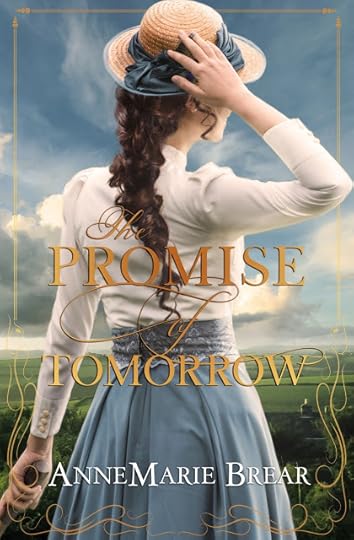
Charlotte Brookes flees her lecherous guardian, McBride, taking her younger sister with her. After a year on the road, they stumble into a Yorkshire village where the Wheelers, owners of the village shop, take them in. This new life is strange for Charlotte, but preferable to living with McBride or surviving on the roads.
Harry Belmont is an important man in the village, but he’s missing something in his life. His budding friendship with Charlotte gives him hope she will feel more for him one day, and he will marry the woman he yearns for.
When McBride discovers where Charlotte lives, his threats begin. Harry fights to keep Charlotte safe, but World War I erupts and Harry enlists.
Left to face a world of new responsibilities, and Harry’s difficult sister, Charlotte must run the gauntlet of family disputes, McBride's constant harassment, and the possibility of the man she loves being killed.
Can Charlotte find the happiness that always seems under threat, and will Harry return home to her?
Excerpt:
‘I arrived home yesterday.’ Harry stared around the warm, neat shop. He moved to the fire and put his hands out to the flames, not wanting to think about the disastrous visit to London. ‘How’s everything in the village?’
‘All is well, as far as I know, anyway.’ Wheeler held up one of the tall glass jars of boiled sweets. ‘For the children?’
‘Yes, thank you. A quarter of each that you have, please.’
‘Those pit children are fortunate to have such a generous employer as you.’ As Wheeler started weighing out the brightly coloured sweets, a young woman walked out from the rear doorway and paused beside him.
Harry stared at her, never having seen her before. His heart gave a jolt, surprising him. A tingle of physical awareness gripped his whole body.
‘Master Harry?’
Realising that Stan Wheeler had been speaking to him, Harry gave a little cough and tried to recapture his reeling senses. The young woman before him was a delicate beauty. ‘You-you have a new assistant, Mr Wheeler?’
‘Indeed, Master Harry, for nearly six weeks now.’ Wheeler grinned, his whole demeanour showing his happiness. ‘Charlotte, this is Mr Harry Belmont, of Belmont Hall. Master Harry, may I present Miss Charlotte Brookes.’
Harry held out his hand and she tentatively took it for a second before slipping her hands behind her slender back. She wore a huge white apron over a simple black dress. Her hair, the colour of deep chestnut mixed with copper was wound in a tight bun at the back of her head, but a few stray tendrils had escaped and hung over her small ears. Her eyes were a blend of green and dark gold. Colour heightened the unblemished skin on her cheeks. It took him but a moment to notice all these things and wonder at his own astonishment to her appearance. She was attractive, certainly, but he’d seen beautiful women before. So why did this one, a shop girl, rob him of both breath and sensible thought?
‘Charlotte and her younger sister, Hannah, are staying with us, you see. They are now without family.’ Wheeler gave her a pat on the shoulder in sympathy before regaining his sunny nature once more. ‘But they have settled in so well here. Bessie and myself can’t think of how it once was without them. Such help they are to us.’
Harry watched Miss Brookes as she smiled softly at Wheeler, the affection between them was mutual it seemed. He wanted to speak to her but didn’t know what to say. A first for him.
Wheeler continued to fill up the small brown paper bags of sweets. ‘See here now, Charlotte. Master Harry comes in every now and then and buys sweets for the children of the pit rows belonging to his mine. They are the children of the men he employs.’ He opened a new jar of humbugs. ‘A quarter of each kind from the boiled sweets and a dozen strips of liquorice cut again into smaller pieces. It goes on the Belmont Hall’s account.’
‘I see, yes.’ She watched him intently as he used tongs to separate the black liquorice lengths.
‘Are you staying in the village long, Miss Brookes?’ Harry finally managed to say, absorbing the way she absently tucked her hair behind her ear.She looked up at him, startled, her eyes wide as though speaking to him was alarming. ‘I hope so, sir.’
He cringed at the ‘sir’. He didn’t want her to cower before him like a servant. For some reason he sensed she wasn’t made that way. He didn’t know why he thought so, or what proof he had, but he instinctively believed she was strong, determined and in no way ordinary. The manner in how she stood straight-backed and watched Wheeler; the pert thrust of her chin as she helped him to weigh and bag the sweets. Her movements were neat and precise and Harry knew at that instant that he could watch her for the rest of his life.
Amazon US • Amazon UK
AnneMarie Brear
 AnneMarie was born a small town in N.S.W. Australia, to English parents from Yorkshire. She is the youngest of five children. Her love of reading fiction started at an early age with Enid Blyton’s novels, before moving on into more adult stories such as Catherine Cookson’s novels as a teenager. Living in England, during the 1980s she discovered a love of history by visiting the many and varied places of historical interest.
AnneMarie was born a small town in N.S.W. Australia, to English parents from Yorkshire. She is the youngest of five children. Her love of reading fiction started at an early age with Enid Blyton’s novels, before moving on into more adult stories such as Catherine Cookson’s novels as a teenager. Living in England, during the 1980s she discovered a love of history by visiting the many and varied places of historical interest.The road to publication was long and winding with a few false starts, but she finally became published in 2006. Since that time, many novels and several short stories have been published. She writes historical novels set in Yorkshire and/or Australia in the eras covering from Victorian to WWII. Her books are available in ebook and paperback from bookstores, especially online bookstores such as Amazon.
AnneMarie enjoys reading and gardening. Spending time visiting old country house estates and castles helps her find ideas for her books. She’s interested in genealogy and researched her family trees. She loves chocolate (who doesn't?) and enjoys travelling, cooking and surfing the web (research purposes, obviously, not wasting time on Facebook!)
AnneMarie loves to hear from readers, you can find her: Website • Twitter• Facebook• Goodreads.
Published on September 26, 2018 23:00
September 25, 2018
It’s an Arden’ough’ life... by Judith Arnopp #Medieval #dissolution #monastichistory @JudithArnopp
It’s an Arden’ough’ life...By Judith Arnopp
Many years ago now I was lucky enough to study medieval monastic history beneath the tutorage of Janet Burton. I attended her first lecture with a idealistic view of the medieval period. For me then the medieval period was a crystal clear world in which the laity were shielded from their sin by the selfless devotion of the Roman church. I signed up to the module on monasticism expecting to study a simple life, goodly men praying for the souls of their fellows. The monks of my imagination were self-denying, nurturing, healing. The nuns were Ingrid Bergman figures, their faces illuminated with religious goodness, mouthing gentle prayers in softly lit chapels, accompanied wherever they went by strains of plainsong. A single lecture with Janet shattered this ideal and made me sit bolt upright and vow that one day I would write a historical novel about nuns.

François Bonvin [Public domain or Public domain], via Wikimedia Commons
Popular history tends to focus on the vast abbeys like Fountains, Glastonbury and Rievaulx which somewhere along the way lost sight of the simple life they initially embraced. By the time of the dissolution these abbeys had become immensely rich and in some cases, were no stranger to corruption. In the case of the Cistercians, who had broken from the mainstream monastic way to ahdere closer to the rule of St Benedict, and forbidden the extravagance of stained glass, patterned floor tiles and multitudinous chapels, the regulations were clearly breached. But it was difficult to avoid. By way of securing themselves a place in Heaven, laymen endowed lavish gifts on the abbeys: gifts of land, chapels, windows etc. They paid for prayers to be said for their souls for all eternity. Ultimately the wealth of the monasteries outstripped that of the crown. It was affluence that drew the greedy eye of Cromwell and his king, and the accusations of corruption had less to do with outrage and more to do with the desire to justify their plundering of the holy church.
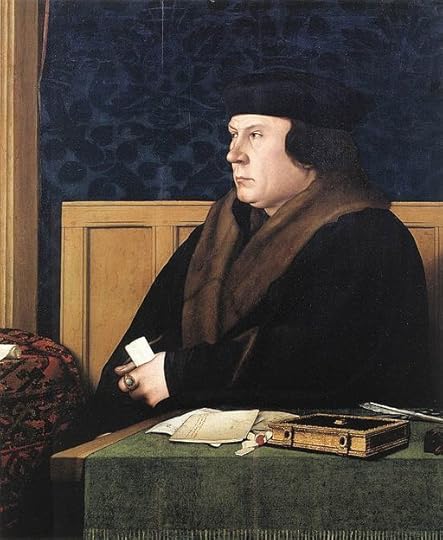 Hans Holbein [Public domain], via Wikimedia Commons
Hans Holbein [Public domain], via Wikimedia CommonsCromwell’s campaign to close the monasteries began slowly at first. Picking up where his old master, Wolsely, had left off, he began tentatively chipping away at smaller, less profitable foundations or houses where moral decay had become the rule rather than the exception. Abbey treasures went straight into the king’s coffers, the lands became the property of the crown, leased to the king’s favourites by way of securing both their loyalty and ensuring their support for the dissolution of the monasteries. But some of the smaller abbeys closed at this time were barely scraping a living. Arden Priory was situated in an unpopulated region on the edge of the North Yorkshire moors, the inhabitants now nothing more than a whisper on the historical record. There was nothing romantic about the cheerless life they led. The nuns at Arden were a group of half starved women living on the edge of civilisation, closed off from the world, from family and friends and all comforts. Assisted by just a few servants, the women undertook all manual work themselves, caring for livestock, cooking, cleaning, nursing … everything. Even today, stripped of twenty-first century luxuries of glazing and heating, life in rural North Yorkshire can be hard; in 1536 it was extreme.

Arden Hall on the site of the priory. Uncredited / Arden Hall via Wikimedia
Arden Priory was founded in 1150 by Peter de Hoton, confirmed by Roger de Mowbray between 1147 and 1169. It was never a rich foundation. One can only imagine the misery of a life of unceasing labour, meagre accommodation, glassless windows, fasting, overworked and ill-clad. In 1397, long before the dissolution, there were just six nuns at Arden: Christina and Elizabeth Darrel, Elizabeth Slayne, Alicia Barnard Agnes of Middleton, and Elizabeth of Thronton. They were overseen by the Prioress, who is named simply as Eleanor. At this time it seems relations between the nuns was not good. The sisters accused the prioress of pawning the church silver, selling wood without consent and providing so few candles in the quire that there was insufficient light to say the offices. They also complained the buildings were in a state of disrepair. But this doesn’t necessarily suggest the prioress was corrupt, it rather points to dire need. Janet Burton in her book Monasteries and Society in the British Isles in the Late Middle Ages says:
“What emerges from their complaints is that this small community of seven women, living in the bleak environment of the North Yorkshire Moors, was suffering conditions of extreme poverty and hardship. It was life on the edge.”
This picture of hardship, so far from my initial imaginings, has stayed with me during the ten years or so since I first heard of Arden. Being so far from the ‘concourse of men’ there few rich benefactors, the priory would have had little chance of increasing their wealth. If there was such a degree of poverty in the fourteenth century, what was the financial state by the time of the dissolution? ‘Valor Ecclesiasticus’ (a survey of church finances in England, Wales and parts of Ireland made in 1535 on Henry VIII’s orders) suggests that very little had changed. Poverty was aways the rule at Arden.
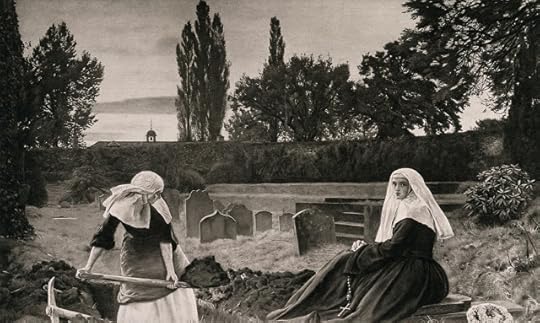 Young nun digging a grave — Wikipedia
Young nun digging a grave — WikipediaThe priory was visited by the king’s commissioners on 8thMay 1536 and it was suppressed the following August. At the time of dissolution there were just six sisters, three of whom received pensions of twenty shillings each, two of ten shillings and one six shillings and eightpence. Sister Elizabeth Johnson, who was an octgenarian with limited hearing was granted forty shillings ‘toward her sustenance.’ The church ‘treasure’ seized by the king’s men consisted of a gilt challice weighing 14.5 oz and a flat piece of white silver weighing 8oz, and two bells valued at ten shillings. According to the ‘Valor Ecclesiasticus’ the value of the house in 1536 was £12. 0s and 6d. It is noted that the nuns also had an image of St Brigid to whom they made offerings for cows that were ill or had strayed. This points to a reality quite different from tales that were circulated in 1536 of corruption and ungodliness. Motivated by his favour of the new learning Cromwell and his men put forward stories of nuns indulging in sexual misconduct with monks, murdering their own infants, enjoying lewd and promiscuous lives. Even if they had the inclination, I would be surprised if the nuns of Arden found either the time or the energy for such practices.
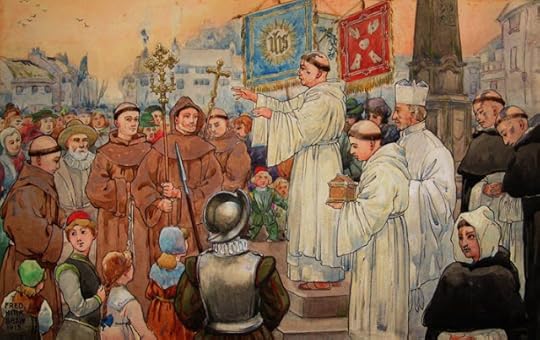
The dissolution was almost universally resented by monks and traditionalists. Monasteries were a life-line; common people relied on them from birth to death for charity, employment and for healthcare. The closures united the populace both rich and poor, culminating in widespread protest that posed the biggest threat to the crown during Henry VIII’s reign. The first rising took place in Lincolnshire in October but was quickly put down, only to spring up again in Yorkshire when the people of the north, led by lawyer, Robert Aske, embarked upon a ‘Pilgrimage of Grace’.
 Richard Croft / Lincolnshire Rising plaque
Richard Croft / Lincolnshire Rising plaqueGentry as well as commonfolk joined the peaceful march to persuade the king to change his mind; monks and laymen, nuns and children were among those who took to the road to preserve their way of life. The Pilgrimage of Grace was the worst uprising during Henry VIII’s reign, the rebels reaching more than 30,000, far outnumbering the royal army but after initially agreeing to consider their complaints, the king managed to get the upper hand. He ‘invited’ Robert Aske to spend Christmas at court, promising to consider their requests but when unrest broke out again in the East Riding it provided the king with the excuse he needed. The Duke of Norfolk was sent to deal with the rebels. The leaders were executed, and there were widespread hangings of common people, a deterrent to further protesters. Robert Aske was hung in chains on the walls of York and left to die.
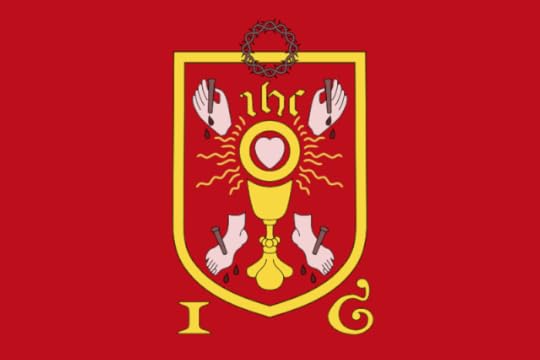 By Banner_of_the_Holy_Wounds_(Pilgrimage_of_Grace).png: self-createdderivative work: Diego Sanguinetti [Public domain], via Wikimedia Commons.
By Banner_of_the_Holy_Wounds_(Pilgrimage_of_Grace).png: self-createdderivative work: Diego Sanguinetti [Public domain], via Wikimedia Commons.One by one the abbeys fell, monks and nuns were turned out, some abbots were tortured and executed. By 1540 the largest of the abbeys were closed, the lands distributed among the nobilty, the remains of once glorious buildings subjected to neglect and decay. The plight of those affected by the dissolution has always intrigued me and I have enjoyed revisiting the period in Sisters of Arden which is due for publication later on this year. The records of Arden are scanty but by piecing together what little we know with wider records of the dissoultion and the pilgrimage of Grace, I have at last been able to explore the closure of the abbeys and the uprisings that followed from the perspective of a group of insignificant nuns. Sisters of Arden follows the path of three nuns, Margery, Grace and Frances, from the closure of Arden, through the journeyings of the pilgrims on their march for Grace, where they experience the outside world for the first time. As their adventures take them the length and breadth of Yorkshire they move from determination to despair, from hope to disillusion. But, with their world in pieces, the only thing they can do is try to rebuild it.
Sisters of Arden

Arden Priory has remained unchanged for almost four hundred years. When a nameless child is abandoned at the gatehouse door, the nuns take her in and raise her as one of their own.After the execution of Anne Boleyn in 1536, the embittered King strikes out, and unprecedented change sweeps across the country. The bells of the great abbeys fall silent, the church fragments and the very foundation of the realm begins to crack. Determined to preserve their way of life, Margery and the sisters of Arden join a pilgrimage thirty thousand strong and attempt to lead the heretic king back to grace.Sisters of Arden is a story of valour, virtue and veritas.
Coming soon — December 2018
Judith Arnopp
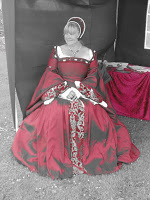 Judith Arnopp is the author of ten historical novels including The Winchester Goose, The Beaufort Chronicle (three book series), The Kiss of the Concubine and A Song of Sixpence. You can find her on Facebook • Twitter • Website • Blog.
Judith Arnopp is the author of ten historical novels including The Winchester Goose, The Beaufort Chronicle (three book series), The Kiss of the Concubine and A Song of Sixpence. You can find her on Facebook • Twitter • Website • Blog.
Published on September 25, 2018 23:00
September 24, 2018
Author's Inspiration — Richard III — Loyalty Binds Me by Matthew Lewis #RichardIII #Plantagenet #History @MattLewisAuthor
Richard III — Loyalty Binds Me
By Matthew Lewis

Everyone knows about Richard III. Or at least, they think they do. For many, Shakespeare’s portrayal represents the facts of Richard’s story, maybe with a little embellishment, but it is generally about right. If anyone is any doubt, then Sir Thomas More and Polydore Vergil amongst others are on hand to put them straight. There are plenty of biographies of Richard III, so the question I had to ask was whether there was room for another on the crowded bookshelves of readers.
My hope is that this book will help to provide a more rounded assessment of Richard than many others do. If anyone doesn’t already know or hasn’t already guessed, I’m a Ricardian. There. I said it.
Oh, you’re still reading. Excellent! Sorry.
There are a lot of books that focus on a particular element of Richard III’s life, mainly around 1483, the fate of his nephews, the Princes in the Tower, or the Battle of Bosworth. Far less books try to place Richard’s entire life in the context of the time in which he lived. This book is the longest I’ve ever written (hopefully readers won’t feel it too much!). It’s 200,000 words and about half of it concentrates on the years before 1483. I don’t think we can really hope to understand the Richard who dealt with the crises of that year without knowing the man who arrived in London that spring.
 King Edward V and the Duke of York in the Tower of London by Paul Delaroche — Wikipedia.
King Edward V and the Duke of York in the Tower of London by Paul Delaroche — Wikipedia.So much of what happened between April and July 1483 remains enveloped in too much foggy, murky uncertainty to be resolved with any degree of certainty. I have tried to present Richard as he grew and developed interests, some of which were undoubtedly obsessions, because several of them are at play in 1483. Was Richard entirely genuine during those months? Was he a scheming monster bent on murdering his way to the throne? Might he have been duped by the story of his nephews’ illegitimacy? Or did he simply lurch from one disaster to another in a downward spiral of reactionary panic?
This biography is undoubtedly positive, and unashamedly so, though the intention is not to provide a whitewashed Richard to counter the dark legend of more traditional history. Some of Richard’s plans, ideas and passions lay at the heart of his downfall, but perhaps not for the reason many people think. The last attempt to revise Richard’s historical reputation in a full biography was made by Paul Murray Kendall in 1955. Almost every other account of his life has clung stubbornly to the traditional image of a power-mad homicidal maniac who, most conclude, murdered his nephews and stole the throne based on lies and treachery. I think there is room for a fresh look at Richard’s life without all of the centuries of accumulated grime and muck that clings to it.
Here’s an example, which is not really directly about Richard, but which is typical of the accepted versions of his story. On 13 June 1483, at an infamous meeting of part of the Council, we are told that Richard has Lord Hastings arrested and summarily beheaded. Thomas Stanley is arrested, some accounts claiming he was injured or nearly killed in the scuffle. Thomas Rotherham, Archbishop of York and John Morton, Bishop of Ely are also seized and imprisoned. There is an interesting anomaly within this story in almost all of its later versions. If we go back to the strictly contemporary writers of 1483, it is easy to pick out.
Dominic Mancini, a source which is vital but given far too much credence, noted that Hastings was in fact killed in the Council chamber in the uproar of an accusation of treason against him. He tells us that Rotherham and Morton were arrested and several others were at the Tower at the time. A record of the events of that day kept by an anonymous London citizen note that Hastings was arrested and beheaded, Rotherham and Ely were arrested, and that Edward IV’s former secretary Oliver King was also taken. The Crowland Chronicler, writing his account up in 1486 but a witness to many of the vents, said that Hastings was executed, and Rotherham and Morton arrested.
None of these accounts place Thomas, Lord Stanley at the meeting in the Tower on 13 June 1483. In fact, he would walk in a place of honour at Richard III’s coronation on 6 July. I strongly suspect that as this moment became viewed as the point at which Richard decided to eliminate those who he feared would openly support Edward V, Stanley wanted in on the action. He may have told later writers that he was there, even that he was wounded trying to protect the rights of Edward V. Stanley family ballads would soon portray Thomas as an uncle and protector to Elizabeth of York, the sister of the Princes in the Tower and queen to Henry VII. He positioned himself as a defender of the House of York, at least as represented by Edward IV and his children.
I suspect Stanley’s presence on 13 June 1483 is a later addition, probably of his own devising. Those writing about it at or very close to the time unanimously do not place him there. I think he embellished the event to show that he took one for the team and tried all that he could to save Edward V. He was lucky to escape with his head, but he was one of just four men arrested for being perceived as too close to Edward V. In fact, he doesn’t appear to have been arrested, or event to have been present. If he was, his position at the coronation a few weeks later would seem odd.
Ultimately, whether there is space on readers’ bookshelves for another Richard III book remains to be seen, as does the willingness of those with a deeply entrenched view to Richard to entertain any alteration to it. For me, it was a book I really wanted to write and I story I believe deserves to be told.
Richard III — Loyalty Binds Me
 King Richard III remains one of the most controversial figures in British history. Matthew Lewis’s new biography aims to become a definitive account by exploring what is known of his childhood and the impacts it had on his personality and view of the world. He would be cast into insecurity and exile only to become a royal prince before his tenth birthday.
King Richard III remains one of the most controversial figures in British history. Matthew Lewis’s new biography aims to become a definitive account by exploring what is known of his childhood and the impacts it had on his personality and view of the world. He would be cast into insecurity and exile only to become a royal prince before his tenth birthday.As Richard spends his teenage years under the watchful gaze of his older brother, Edward IV, he is eventually placed in the household of their cousin, the Earl of Warwick, remembered as the Kingmaker; but as the relationship between a king and his most influential magnate breaks down, Richard is compelled to make a choice when the House of York fractures. After another period in exile, Richard returns to become the most powerful nobleman in England. The work he involves himself in during the years that follow demonstrates a drive and commitment but also a dangerous naïveté.
When crisis hitsin 1483, it is to Richard that his older brother turns on his death bed. The events of 1483 remain contentious and hotly debated, but by understanding the Richard who began that year, it will become clearer what drove some of his actions and decisions. Returning to primary sources and considering the evidence available, this new life undoes the myths and presents a real man living in tumultuous times.
Amazon UK • Amazon US • Book Depository
Matthew Lewis
 Matthew Lewis was born and grew up in the West Midlands. Having obtained a law degree, he currently lives in the beautiful Shropshire countryside with his wife and children. History and writing have always been a passion of Matthew's, with particular interest in the Wars of the Roses period. His first novel, Loyalty, was born of the joining of those passions.
Matthew Lewis was born and grew up in the West Midlands. Having obtained a law degree, he currently lives in the beautiful Shropshire countryside with his wife and children. History and writing have always been a passion of Matthew's, with particular interest in the Wars of the Roses period. His first novel, Loyalty, was born of the joining of those passions.Matthew loves to hear from readers, you can find him on: Blog • Facebook • Twitter.
Published on September 24, 2018 23:00
September 23, 2018
Myths & Legends of Medieval Wales By Mark Noce #myths #legends #Wales @MarkNoce
Thank you for having me on your blog today, Mary! My second novel in the Queen Branwen Series is Dark Winds Rising, which was published by St. Martin’s Press. Today, I’ll be discussing the mythology that inspired my latest novel and how myth can be very useful to a historical author
What is a myth, really? Just a bunch of lies, right? Well, maybe not. If you think about it, a myth is basically a hypothetical scenario from a different era and culture. Even if the plot of the story may be fabricated, it still provides very real information. It shows you what the people of that time and place believed was right and wrong. It tells you how they thought people should act, what they feared, loved, and a whole host of psychological and societal information. This is very real data that can inform researchers, for both novels and archaeology.
One of the big issues I faced with researching the early Dark Ages of Wales was that very little textual and physical material survived the period. Myths and legends, however, helped fill in many of those missing gaps for me. Oral legends that later were written down by medieval monks, helped preserve aspects of this time period, even when much of the primary history for that time and place were incomplete in modern historical records.
The Tale of Olwen is one of the oldest Arthurian legends and probably originated as an oral tale right around the year 600 AD, if not earlier. This story is a prime example of how myths and legends provided a useful backdrop when construction the Welsh world of the early 600s. In the Tale of Olwen, things like kinship, bravery, and fairness are clearly valued. A mix of humor and tragedy also pervades the tone of several early Welsh texts. Their Celtic roots were apparent even when they were Christianized. The very names of their monarchs and nobles inscribed in churchyards is a testament to this. Old Celtic names actually resurged in popularity after the Roman period, showing a continuity with their Celtic ancestors. While at the same time their legends are also full of the importance of holy clerics and Christian teaching. It’s an interesting mix, and provides wonderful inspiration for an author like myself.
Other Welsh legends contained in the Mabinogion, also offer tantalizing clues regarding this “lost” world of early medieval Wales. We see strong heroines, like Rhiannon, and mention of long lost queens who ruled equally beside their husbands. These often overlooked details offers new conceptions of gender roles in Wales, especially when contrasted with the more male-dominated societies of the waning Romans and the invading Saxons. As alien as an ancient culture may seem, there are elements that we can relate to today that they would have also valued. Things like family, justice, independence, and equality did exist in various measures in the dangerous world of medieval Wales.
I hope you enjoy reading Dark Winds Rising! It was a joy to write and will hopefully give you a new perspective of the Welsh, and the history of the early medieval period. Dark Winds Rising is the second novel in the Queen Branwen Series, the first book being Between Two Fires. Both are published via St. Martin’s Press and are available wherever books are sold. Thanks for reading!

Dark Winds Rising
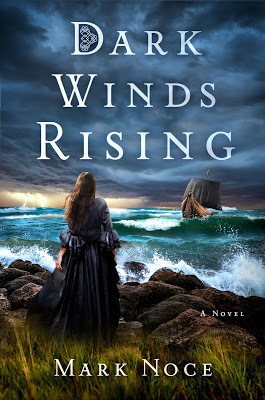 Queen Branwen finds her world once again turned upside down as Pictish raiders harry the shores of her kingdom. Rallying her people once more, she must face her most dangerous foe yet, the Queen of the Picts. Ruthless and cunning, the Pictish Queen turns the Welsh against each other in a bloody civil war, and Branwen must attempt to stop her before her country threatens to tear itself apart. All the while Branwen is heavy with child, and finds her young son’s footsteps dogged by a mysterious assassin. Branwen must somehow defeat the Picts and save her people before the Pictish Queen and a mysterious assassin threaten to destroy their lives from the inside out.
Queen Branwen finds her world once again turned upside down as Pictish raiders harry the shores of her kingdom. Rallying her people once more, she must face her most dangerous foe yet, the Queen of the Picts. Ruthless and cunning, the Pictish Queen turns the Welsh against each other in a bloody civil war, and Branwen must attempt to stop her before her country threatens to tear itself apart. All the while Branwen is heavy with child, and finds her young son’s footsteps dogged by a mysterious assassin. Branwen must somehow defeat the Picts and save her people before the Pictish Queen and a mysterious assassin threaten to destroy their lives from the inside out.
“A spirited ride through a turbulent slice of Welsh history!” – Paula Brackston, NYT Bestselling author of The Witch’s Daughter
“A fast-paced read that has a wonderfully visual style and some memorable characters. Mark Noce combines Welsh history with a touch of folkloric magic in this promising debut novel. Lady Branwen is a strong and engaging narrator and the turbulent setting of early medieval Wales makes a fine backdrop for an action-packed story.” – Juliet Marillier, Bestselling author of Daughter of the Forest and Wolfskin
Amazon • Barnes & Noble • St. Martin’s Press
Mark Noce Mark Noce writes historical fiction with a passion, and eagerly reads everything from fantasy to literature. Born and raised in the San Francisco Bay Area, he’s an avid traveler and backpacker, particularly in Europe and North America. He earned his BA and MA from Cal Poly, San Luis Obispo, where he also met his beautiful wife. By day, he works as a Technical Writer, having spent much of his career at places like Google and Facebook. In addition to writing novels, he also writes short fiction online. When not reading or writing, he’s probably listening to U2, sailing his dad’s boat, or gardening with his family. Find out more at Mark's website Marknoce.com and find him on Facebook and Twitter @MarkNoce
Mark Noce writes historical fiction with a passion, and eagerly reads everything from fantasy to literature. Born and raised in the San Francisco Bay Area, he’s an avid traveler and backpacker, particularly in Europe and North America. He earned his BA and MA from Cal Poly, San Luis Obispo, where he also met his beautiful wife. By day, he works as a Technical Writer, having spent much of his career at places like Google and Facebook. In addition to writing novels, he also writes short fiction online. When not reading or writing, he’s probably listening to U2, sailing his dad’s boat, or gardening with his family. Find out more at Mark's website Marknoce.com and find him on Facebook and Twitter @MarkNoce
What is a myth, really? Just a bunch of lies, right? Well, maybe not. If you think about it, a myth is basically a hypothetical scenario from a different era and culture. Even if the plot of the story may be fabricated, it still provides very real information. It shows you what the people of that time and place believed was right and wrong. It tells you how they thought people should act, what they feared, loved, and a whole host of psychological and societal information. This is very real data that can inform researchers, for both novels and archaeology.
One of the big issues I faced with researching the early Dark Ages of Wales was that very little textual and physical material survived the period. Myths and legends, however, helped fill in many of those missing gaps for me. Oral legends that later were written down by medieval monks, helped preserve aspects of this time period, even when much of the primary history for that time and place were incomplete in modern historical records.
The Tale of Olwen is one of the oldest Arthurian legends and probably originated as an oral tale right around the year 600 AD, if not earlier. This story is a prime example of how myths and legends provided a useful backdrop when construction the Welsh world of the early 600s. In the Tale of Olwen, things like kinship, bravery, and fairness are clearly valued. A mix of humor and tragedy also pervades the tone of several early Welsh texts. Their Celtic roots were apparent even when they were Christianized. The very names of their monarchs and nobles inscribed in churchyards is a testament to this. Old Celtic names actually resurged in popularity after the Roman period, showing a continuity with their Celtic ancestors. While at the same time their legends are also full of the importance of holy clerics and Christian teaching. It’s an interesting mix, and provides wonderful inspiration for an author like myself.
Other Welsh legends contained in the Mabinogion, also offer tantalizing clues regarding this “lost” world of early medieval Wales. We see strong heroines, like Rhiannon, and mention of long lost queens who ruled equally beside their husbands. These often overlooked details offers new conceptions of gender roles in Wales, especially when contrasted with the more male-dominated societies of the waning Romans and the invading Saxons. As alien as an ancient culture may seem, there are elements that we can relate to today that they would have also valued. Things like family, justice, independence, and equality did exist in various measures in the dangerous world of medieval Wales.
I hope you enjoy reading Dark Winds Rising! It was a joy to write and will hopefully give you a new perspective of the Welsh, and the history of the early medieval period. Dark Winds Rising is the second novel in the Queen Branwen Series, the first book being Between Two Fires. Both are published via St. Martin’s Press and are available wherever books are sold. Thanks for reading!

Dark Winds Rising
 Queen Branwen finds her world once again turned upside down as Pictish raiders harry the shores of her kingdom. Rallying her people once more, she must face her most dangerous foe yet, the Queen of the Picts. Ruthless and cunning, the Pictish Queen turns the Welsh against each other in a bloody civil war, and Branwen must attempt to stop her before her country threatens to tear itself apart. All the while Branwen is heavy with child, and finds her young son’s footsteps dogged by a mysterious assassin. Branwen must somehow defeat the Picts and save her people before the Pictish Queen and a mysterious assassin threaten to destroy their lives from the inside out.
Queen Branwen finds her world once again turned upside down as Pictish raiders harry the shores of her kingdom. Rallying her people once more, she must face her most dangerous foe yet, the Queen of the Picts. Ruthless and cunning, the Pictish Queen turns the Welsh against each other in a bloody civil war, and Branwen must attempt to stop her before her country threatens to tear itself apart. All the while Branwen is heavy with child, and finds her young son’s footsteps dogged by a mysterious assassin. Branwen must somehow defeat the Picts and save her people before the Pictish Queen and a mysterious assassin threaten to destroy their lives from the inside out.“A spirited ride through a turbulent slice of Welsh history!” – Paula Brackston, NYT Bestselling author of The Witch’s Daughter
“A fast-paced read that has a wonderfully visual style and some memorable characters. Mark Noce combines Welsh history with a touch of folkloric magic in this promising debut novel. Lady Branwen is a strong and engaging narrator and the turbulent setting of early medieval Wales makes a fine backdrop for an action-packed story.” – Juliet Marillier, Bestselling author of Daughter of the Forest and Wolfskin
Amazon • Barnes & Noble • St. Martin’s Press
Mark Noce
 Mark Noce writes historical fiction with a passion, and eagerly reads everything from fantasy to literature. Born and raised in the San Francisco Bay Area, he’s an avid traveler and backpacker, particularly in Europe and North America. He earned his BA and MA from Cal Poly, San Luis Obispo, where he also met his beautiful wife. By day, he works as a Technical Writer, having spent much of his career at places like Google and Facebook. In addition to writing novels, he also writes short fiction online. When not reading or writing, he’s probably listening to U2, sailing his dad’s boat, or gardening with his family. Find out more at Mark's website Marknoce.com and find him on Facebook and Twitter @MarkNoce
Mark Noce writes historical fiction with a passion, and eagerly reads everything from fantasy to literature. Born and raised in the San Francisco Bay Area, he’s an avid traveler and backpacker, particularly in Europe and North America. He earned his BA and MA from Cal Poly, San Luis Obispo, where he also met his beautiful wife. By day, he works as a Technical Writer, having spent much of his career at places like Google and Facebook. In addition to writing novels, he also writes short fiction online. When not reading or writing, he’s probably listening to U2, sailing his dad’s boat, or gardening with his family. Find out more at Mark's website Marknoce.com and find him on Facebook and Twitter @MarkNoce
Published on September 23, 2018 23:00
September 21, 2018
The Battle of Stamford Bridge by The Ancient History Guy #Hastings #BattleofStamfordBridge #history @ancient_guy
Today’s special guest on Myths, Legends, Books & Coffee Pots is…
The Ancient History Guy

The Ancient History Guy is a youtube channel dedicated to making History fun and interesting via animation. Here we have created a format that can both be used for teachers, homeschoolers, and the casual viewer who wants to learn a bit about history! New videos every Monday!
The Battle of Stamford Bridge 25th September 1066
The Battle of Stamford Bridge was the result of a succession crisis in 1066 between three claimants to the English Throne. The battle between the two claimants Harold Godwinson and Harald Hardrada would be one of the most important battles fought for the English Throne in 1066.
New Videos every Monday.

Published on September 21, 2018 23:00
The Coffee Pot Book Club
The Coffee Pot Book Club (formally Myths, Legends, Books, and Coffee Pots) was founded in 2015. Our goal was to create a platform that would help Historical Fiction, Historical Romance and Historical
The Coffee Pot Book Club (formally Myths, Legends, Books, and Coffee Pots) was founded in 2015. Our goal was to create a platform that would help Historical Fiction, Historical Romance and Historical Fantasy authors promote their books and find that sometimes elusive audience. The Coffee Pot Book Club soon became the place for readers to meet new authors (both traditionally published and independently) and discover their fabulous books.
...more
...more
- Mary Anne Yarde's profile
- 159 followers



